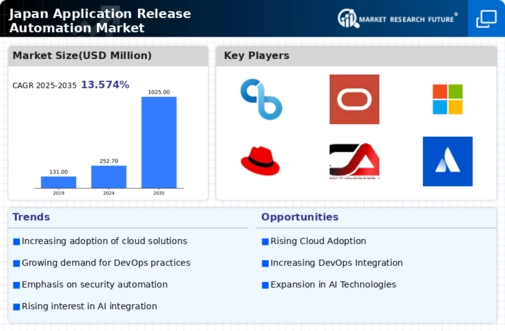Growing Focus on DevOps Practices
The application release-automation market is witnessing a growing focus on DevOps practices among Japanese enterprises. This approach emphasizes collaboration between development and operations teams, fostering a culture of continuous integration and delivery. As organizations recognize the benefits of DevOps, such as reduced time-to-market and enhanced product quality, the demand for automation tools that facilitate these practices is expected to rise. Recent surveys suggest that over 60% of Japanese firms are adopting DevOps methodologies, which directly correlates with the expansion of the application release-automation market. This trend indicates a shift towards more streamlined and efficient software development processes.
Rising Demand for Agile Development
The application release-automation market in Japan is experiencing a notable surge in demand for agile development methodologies. Organizations are increasingly adopting agile practices to enhance their software development processes, which necessitates the integration of automation tools. This shift is driven by the need for faster release cycles and improved collaboration among development teams. According to recent data, approximately 70% of Japanese companies are implementing agile frameworks, which directly influences the growth of the application release-automation market. As businesses strive to remain competitive, the adoption of automation solutions that support agile practices is likely to become a critical factor in their operational strategies.
Integration of Artificial Intelligence
The integration of artificial intelligence (AI) into the application release-automation market is transforming how software is developed and deployed in Japan. AI technologies are being utilized to enhance automation processes, enabling predictive analytics and intelligent decision-making. This trend appears to be gaining traction, as organizations seek to optimize their release cycles and reduce human error. Recent statistics indicate that AI-driven automation tools could potentially increase efficiency by up to 40% in software development processes. Consequently, the application release-automation market is likely to see a significant uptick in demand for AI-enhanced solutions, as companies aim to leverage these technologies for improved performance.
Regulatory Compliance and Risk Management
The application release-automation market in Japan is increasingly influenced by the need for regulatory compliance and effective risk management. As businesses face stringent regulations regarding data security and software quality, the demand for automation tools that ensure compliance is on the rise. Organizations are seeking solutions that can streamline their release processes while adhering to regulatory standards. Recent findings indicate that compliance-related issues can lead to significant financial penalties, prompting companies to invest in automation technologies that mitigate these risks. This trend suggests that the application release-automation market will continue to grow as firms prioritize compliance and risk management in their software development practices.
Increased Investment in Digital Transformation
In Japan, there is a marked increase in investment in digital transformation initiatives, which is significantly impacting the application release-automation market. Companies are allocating substantial budgets to modernize their IT infrastructure and adopt innovative technologies. This trend is driven by the need to enhance operational efficiency and improve customer experiences. Data shows that Japanese organizations are expected to invest over $100 billion in digital transformation by 2025, creating a favorable environment for the growth of the application release-automation market. As businesses prioritize automation as a key component of their digital strategies, the demand for release-automation solutions is likely to escalate.





















Leave a Comment